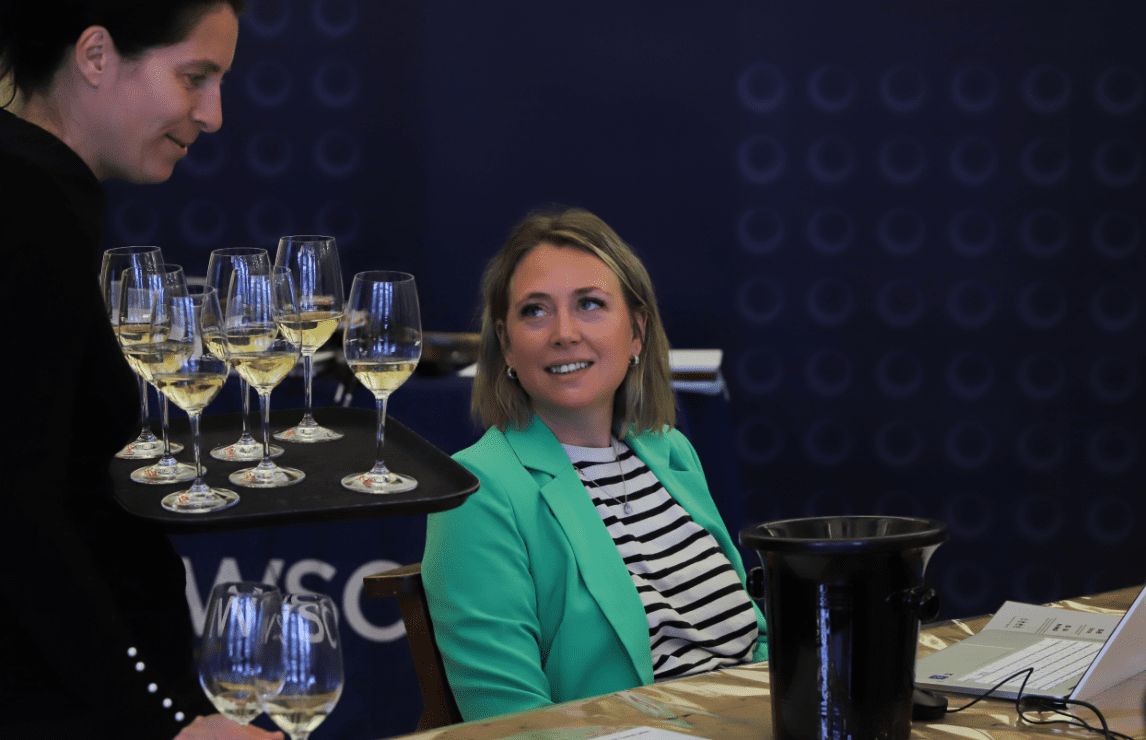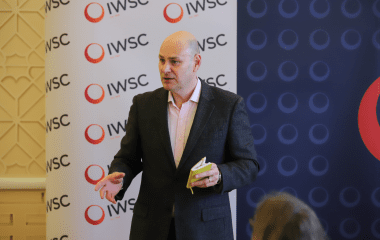IWSC 2024 Wine Judging. Judges’ deliberations: Prosecco, English sparkling and other sparkling wines
This was the loudest day at our Wine Judging so far, with hundreds of corks popping behind the curtains and ice being poured into the buckets, ensuring the bubbles are served at the optimum temperature.
Our Sparkling wine panels were co-chaired by the IWSC Judging Committee members Alistair Cooper MW and John Hoskins MW. This year, the panels were treated to an incredible diversity of sparkling wines from around the world.
English sparkling wines put on a stellar performance this year, with our judging admiring the high quality across the board. Some of the flights wowed our judges so much that they were checking with staff when they would receive the full details of the wines tasted (at the IWSC, all samples are tasted blind, but our judges receive the names of the wines after the results announcement).
“For me, the real excitement was how far the rosé sparkling has come,” said John Hoskins MW. “In the past, we've concentrated on the whites among the English contingent. And we have seen some outstanding Blanc de Blanc today, but this year it was the rosés that really stole the show. I think English winemakers have really mastered that art.”
Two gold medals were awarded to English sparkling rosés, including a particularly standout 96 points gold for a wine that “has a real touch of class, good weight on the palate, impressive texture, great complexity, lingering finish”.
“The English sparkling flights wowed us with their consistent quality. It was fantastic to see how this category has emerged. The English Blanc de Blanc showed some extremely fine wines indeed, indicating the commitment to quality in Sussex, Hampshire and Kent as a whole,” shared the judges.
English Blanc de Blancs earned 2 gold medals and many silvers with the judges admiring the “lovely freshness” and the “long, fine, mousse”.
Further on, the judges appreciated the variety of styles of the English sparkling wines on show: “It was great to see the playground that the UK wine scene has become, with a variety of styles, including some sparkling reds, and non-champagne varieties. It is reflective of the growth of wine knowledge within the wine industry, which is going from strength to strength. The step up in vintage wines was evident.”
Prosecco traditionally dominates our sparkling wine category and this year was no exception with many flights showcasing different subregions and styles of Italy’s famous fizz.
“The Proseccos were fairly consistent with overall great quality, but definitely some stand-outs in all flights. Those wines that could show the intensity of fruit as well as typicity, acidity, balance and length were among those most rewarded,” shared the judges.
Our experts appreciated the evident step up in quality of the Conegliano Valdobbiadene and Cartizze Prosecco. “Cartizze quality shined in all the flights and was very consistent - very good concentration of fruit, well-defined wines, good mouth-coating texture, and benchmark for their style,” the judges noted.
Prosecco Valdobbiadene Brut was one of the standout flights, with a gold medal awarded to the best expression: “very elegant nose; white flowers, citrus and pear on the palate, good linear drive and lifted finish”.
Amongst other Italian sparkling wines, our judges highlighted the Moscato d’Asti flight: “Moscato d'Asti was the most varied flight, which was interesting and evoked good debate among the team. Again, acidity and balance where there is sugar, really helps stand out the good from the great.”
The judges highlighted the 2016 vintage Moscato d’Asti as one of the most remarkable wines on show: “unusual minty and ginger balsamic notes on the forefront are followed by typical aromas of jasmin, lychee, nectarine and other plentiful tropical fruits. The level of ageing brings extra level of complexity contributing to special character of this wine”.
Italian sparkling reds also showed well, with no wines left without a medal and one gold awarded to a “distincly Italian wine with aromas of ripe summer berries and spice, good texture and clean finish.”
Looking beyond traditional sparkling wine regions, Canadian fizz impressed our judges who highlighted that many wines showed excellent use of maturation to develop complexity. An Ontario sparkling received a gold and stellar 96 points with our judges admiring the “beautiful nose of citrus fruit and brioche and the refined palate; there's generous orchard fruit, balanced by waxy citrus, plenty of complexity and depth with a truffled finish.” Another gold went to an Okanagan sparkling: “beautifully-evolving wine; stone fruit, spices, brioche; lovely freshness and spiciness on the palate; long finish and high complexity.”
The judges spoke highly of sparkling wines from Brazil, describing them as ‘surprisingly interesting’, as noting the growing quality of Argentinian fizz: “Lots to love here, showing Argentina's strength in sparkling production.”
Eastern Europe also proved its potential to produce high quality sparkling, with our judges appreciating the opportunity to taste some examples from lesser known and emerging regions. “All of these wines were medal-worthy with some really great quality wines in the line-up, including a silver from Slovakia and some good wines from Ukraine, Croatia and Moldova. Exciting to see more from these regions. The Slovakian wines were more natural in style, and when made well, these wines can be delicious,” shared the judges.
Moving on to Asia, the judges were very pleased with the quality sparkling wines from Japan: “Japanese sparkling wines showed precision, delicacy and skilled craftsmanship, plus the full craziness of Bacchus aromas.” There were some very good sparkling wines from China too, noted the judges, with a beautifully captured Chardonnay character and subtle autolytic notes. One of the standout Chinese wines earned praise for its “red apple, cherry, watermelon nose” and its “crunchy cherry and red apple character with a strawberry mille-feuille finish”.
“We had one very lucky table of judges who had an extraordinary variety of wine. They tasted wines from Canada, Brazil, Argentina, Australia, Chile, Japan, Taiwan, China, and Myanmar. I think they found three gold medals from some pretty unlikely sources,” shared John Hoskins MW. “And this was for me the inspiring part of the day and I think it's great that the IWSC can generate interest from producers in these emerging unusual regions. And please, let's see more of that. Everybody out there should consider entering their wines. If they feel the quality is there, there is no bias against a region just because we haven't seen it very much or given it metals before. Let's taste wines from everywhere. And let's salute the achievements of those lesser known regions!”
Overall, it was a very exciting day of judging sparkling wines with great medal results across the board. The Sparkling wine judging will continue with the Champagne tasting on Monday next week.
Stay tuned for further judges’ deliberations and the results announcement on 20 May.


